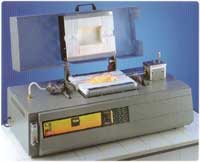| | |
| ||
|
| The Carbolite Rotary Furnace was developed by the Imperial College of Science and Technology, London and is designed for laboratory scale calcination and the production of high temperature reactions in a wide range of materials. The Rotary Reactor combines all the advantages of the fluo-solid (fluidised bed) furnace and the rotary kiln by providing both a controlled atmosphere and at the same time agitation of powdered solids. Additionally, the unit overcomes the problems of long reaction times experienced by combustion in a muffle furnace or under flowing gases in a static tube. | |
| Although originally designed for calcinating colliery spoils at a temperature up to 1000°C, other applications include: |
| |
| General Features | ||
| Constructed of zinc coated steel, the case is finished in a stoved epoxy coating, providing a durable finish. For maximum heat transfer and excellent temperature uniformity, high quality resistance wire elements are used. A positive break switch isolates power to the long-life resistance wire elements whenever the heating chamber is open. A removable exhaust box is provided for occasional cleaning and removal of condensates. The rotating fused silica reaction tube is flutted on the internal surface to ensure good mixing and uniform exposure of the particles to the atmosphere. The material is heated by radiation through the silica tube and the smooth internal profile allows easy loading, unloading and cleaning with minimal powder loss.
| Oscillation of the reaction tube is provided by an electric motor with variable speed control. Gas tight connections ensure the vessel is sealed. An adjustable gas flowmeter with a 30mm scale, calibrated for N2, is supplied as standard. Single or multiple flowmeters for different gases are available as options. The hinged heated chamber design allows easy access for removal and insertion of the quartz vessel. Atmosphere enters the quartz vessel through a flexible silicon rubber tube. The outlet end of the quartz vessel extends into a stainless steel exhaust box. A single gasket seal surrounding the quartz tube prevents atmosphere leakage. A gas outlet port in the exhaust box may be piped to an extraction system.
| |
| Specification Details | ||
| Model | HTR 11/75 | HTR 11/150 | ||
| Maximum Temperature | 1000°C | |||
| Internal Vessel Dimensions (mm) | 75 diameter x 100 | 150 diameter x 200 | ||
| External Furnace Dimensions (mm) Lid Position height width depth | Down 480 1140 550 | Up 800 1140 680 | Down 540 1300 690 | Up 950 1300 900 |
| Vessel Capacity (grams) | 120 | 950 | ||
| Maximum Power (W) | 1500 | 3000 | ||
| Holding Power at 1000°C (W) | 950 | 400 | ||
| Supply Voltage (single phase) | 220/240V | |||
| Heat up time to 100°C below maximum temperature without charge and gas flow (minutes) | 11 | 21 | ||
| Cooling time: 1000°C to 300°C with lid open (minutes) | 8 | |||
| Approximate weight (kg) | 40 | 95 | ||
| Oscillation frequency | 1-8 per minute | |||
| Rotation angle (each direction) | 315° | |||

